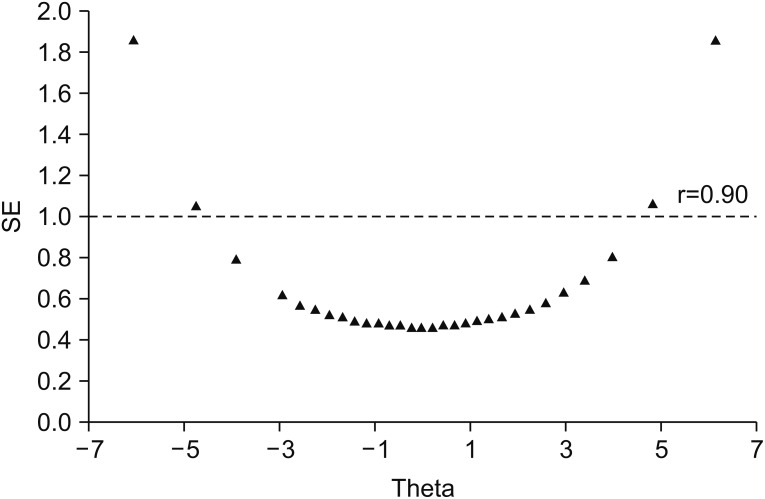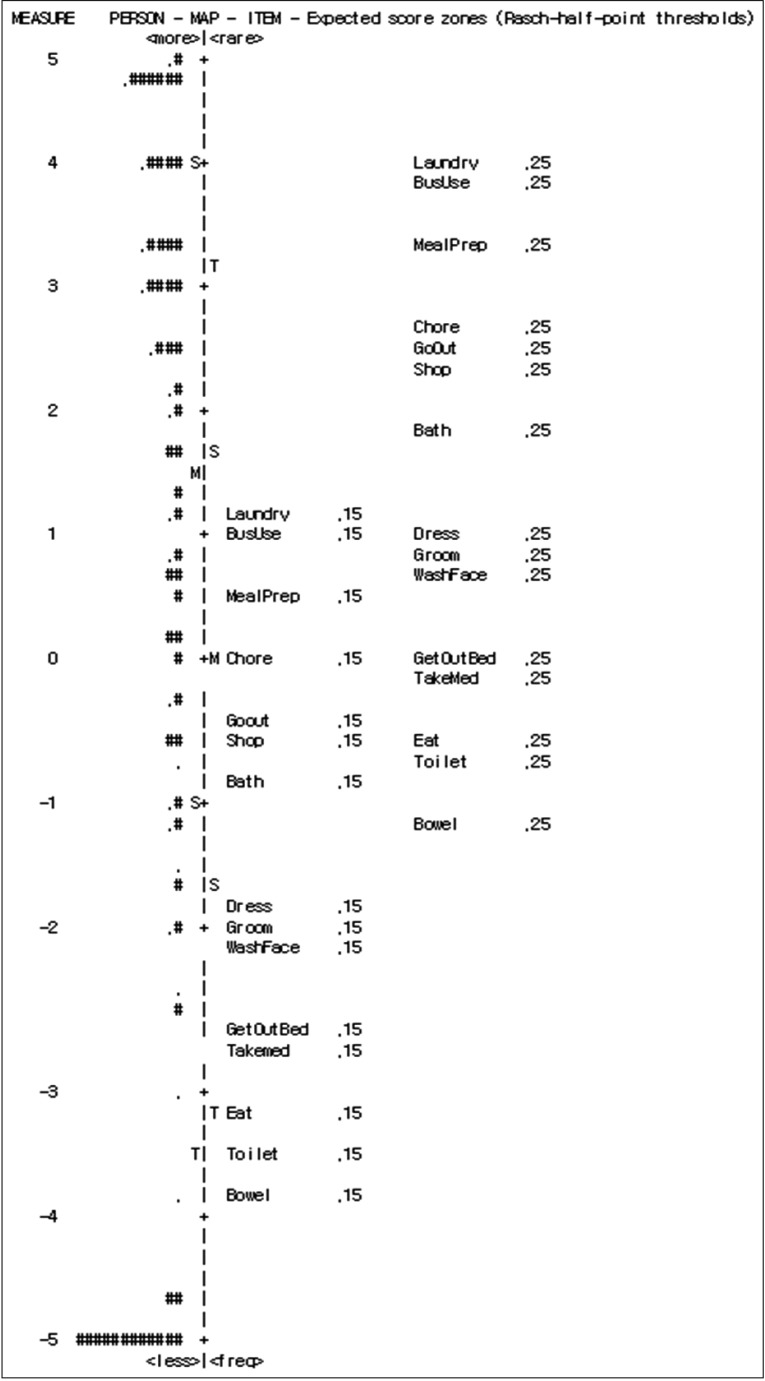Ann Rehabil Med.
2018 Apr;42(2):336-345. 10.5535/arm.2018.42.2.336.
Disability Measurement for Korean Community-Dwelling Adults With Stroke: Item-Level Psychometric Analysis of the Korean Longitudinal Study of Ageing
- Affiliations
-
- 1Department of Occupational Therapy, School of Health Professions, University of Texas Medical Branch, Galveston, TX, USA. ichong@utmb.edu
- 2Department of Occupational Therapy, College of Allied Health Science, East Carolina University, Greenville, NC, USA.
- 3Division of Rehabilitation Sciences, School of Health Professions, University of Texas Medical Branch, Galveston, TX, USA.
- 4Department of Health Sciences and Research, College of Health Professions, Medical University of South Carolina, Charleston, SC, USA.
- KMID: 2432205
- DOI: http://doi.org/10.5535/arm.2018.42.2.336
Abstract
OBJECTIVE
To investigate the psychometric properties of the activities of daily living (ADL) instrument used in the analysis of Korean Longitudinal Study of Ageing (KLoSA) dataset.
METHODS
A retrospective study was carried out involving 2006 KLoSA records of community-dwelling adults diagnosed with stroke. The ADL instrument used for the analysis of KLoSA included 17 items, which were analyzed using Rasch modeling to develop a robust outcome measure. The unidimensionality of the ADL instrument was examined based on confirmatory factor analysis with a one-factor model. Item-level psychometric analysis of the ADL instrument included fit statistics, internal consistency, precision, and the item difficulty hierarchy.
RESULTS
The study sample included a total of 201 community-dwelling adults (1.5% of the Korean population with an age over 45 years; mean age=70.0 years, SD=9.7) having a history of stroke. The ADL instrument demonstrated unidimensional construct. Two misfit items, money management (mean square [MnSq]=1.56, standardized Z-statistics [ZSTD]=2.3) and phone use (MnSq=1.78, ZSTD=2.3) were removed from the analysis. The remaining 15 items demonstrated good item fit, high internal consistency (person reliability=0.91), and good precision (person strata=3.48). The instrument precisely estimated person measures within a wide range of theta (−4.75 logits <θ< 3.97 logits) and a reliability of 0.9, with a conceptual hierarchy of item difficulty.
CONCLUSION
The findings indicate that the 15 ADL items met Rasch expectations of unidimensionality and demonstrated good psychometric properties. It is proposed that the validated ADL instrument can be used as a primary outcome measure for assessing longitudinal disability trajectories in the Korean adult population and can be employed for comparative analysis of international disability across national aging studies.
MeSH Terms
Figure
Reference
-
1. Sonnega A, Faul JD, Ofstedal MB, Langa KM, Phillips JW, Weir DR. Cohort Profile: the Health and Retirement Study (HRS). Int J Epidemiol. 2014; 43:576–585. PMID: 24671021.
Article2. Borsch-Supan A, Brandt M, Hunkler C, Kneip T, Korbmacher J, Malter F, et al. Data resource profile: the Survey of Health, Ageing and Retirement in Europe (SHARE). Int J Epidemiol. 2013; 42:992–1001. PMID: 23778574.3. Steptoe A, Breeze E, Banks J, Nazroo J. Cohort profile: the English longitudinal study of ageing. Int J Epidemiol. 2013; 42:1640–1648. PMID: 23143611.
Article4. Boo KC, Chang JY. Korean longitudinal study of ageing: research design for international comparative studies. Surv Res. 2006; 7:97–122.5. Hong KS, Bang OY, Kang DW, Yu KH, Bae HJ, Lee JS, et al. Stroke statistics in Korea: part I. Epidemiology and risk factors: a report from the Korean stroke society and clinical research center for stroke. J Stroke. 2013; 15:2–20. PMID: 24324935.
Article6. Lim SJ, Kim HJ, Nam CM, Chang HS, Jang YH, Kim S, et al. Socioeconomic costs of stroke in Korea: estimated from the Korea national health insurance claims database. J Prev Med Public Health. 2009; 42:251–260. PMID: 19675402.
Article7. Hong KS, Bang OY, Kim JS, Heo JH, Yu KH, Bae HJ, et al. Stroke statistics in Korea: part II stroke awareness and acute stroke care, a report from the Korean Stroke Society and Clinical Research Center for Stroke. J Stroke. 2013; 15:67–77. PMID: 24324942.
Article8. Shih RA, Lee J, Das L. Harmonization of cross-national studies of aging to the health and retirement study: cognition. Santa Monica: RAND Corporation;2012.9. Buz J, Cortes-Rodriguez M. Measurement of the severity of disability in community-dwelling adults and older adults: interval-level measures for accurate comparisons in large survey data sets. BMJ Open. 2016; 6:e011842.
Article10. Cieza A, Oberhauser C, Bickenbach J, Jones RN, Ustun TB, Kostanjsek N, et al. The English are healthier than the Americans: really. Int J Epidemiol. 2015; 44:229–238. PMID: 25231371.
Article11. Grimby G, Andren E, Holmgren E, Wright B, Linacre JM, Sundh V. Structure of a combination of Functional Independence Measure and Instrumental Activity Measure items in community-living persons: a study of individuals with cerebral palsy and spina bifida. Arch Phys Med Rehabil. 1996; 77:1109–1114. PMID: 8931519.
Article12. Altman BM. Definitions, concepts, and measures of disability. Ann Epidemiol. 2014; 24:2–7. PMID: 24268996.
Article13. Wright BD, Linacre JM. Observations are always ordinal; measurements, however, must be interval. Arch Phys Med Rehabil. 1989; 70:857–860. PMID: 2818162.14. Wright BD, Stone MH. Best test design. Chicago, IL: Mesa Press;1979.15. Chan KS, Kasper JD, Brandt J, Pezzin LE. Measurement equivalence in ADL and IADL difficulty across international surveys of aging: findings from the HRS, SHARE, and ELSA. J Gerontol B Psychol Sci Soc Sci. 2012; 67:121–132. PMID: 22156662.
Article16. Hong I, Yoo EY, Kazley AS, Lee D, Li CY, Reistetter TA. Development and validation of the activities of daily living short form for community-dwelling Korean stroke survivors. Eval Health Prof. 2018; 41:44–66. PMID: 29179561.
Article17. Won CW, Rho YG, Kim SY, Cho BR, Lee YS. The validity and reliability of Korean Activities of Daily Living(KADL) Scale. J Korean Geriatr Soc. 2002; 6:98–106.18. Won CW, Rho YG, SunWoo D, Lee YS. The validity and reliability of Korean Instrumental Activities of Daily Living(K-IADL) Scale. J Korean Geriatr Soc. 2002; 6:273–280.19. Won CW, Yang KY, Rho YG, Kim SY, Lee EJ, Yoon JL, et al. The development of Korean Activities of Daily Living(K-ADL) and Korean Instrumental Activities of Daily Living(K-IADL) Scale. J Korean Geriatr Soc. 2002; 6:107–120.20. Reeve BB, Hays RD, Bjorner JB, Cook KF, Crane PK, Teresi JA, et al. Psychometric evaluation and calibration of health-related quality of life item banks: plans for the Patient-Reported Outcomes Measurement Information System (PROMIS). Med Care. 2007; 45(5 Suppl 1):S22–S31. PMID: 17443115.21. Muthen LK, Muthen BO. Mplus version 7.4 software [Internet]. Los Angeles: statmodel.com;2015. cited 2018 Mar 1. Available from: https://www.statmodel.com/index.shtml.22. Tabachnick BG, Fidell LS. Using multivariate statistics. 5th ed. Boston: Pearson;2006.23. Andrich D. A rating formulation for ordered response categories. Psychometrika. 1978; 43:561–573.
Article24. Linacre JM. A user's guide to WINSTEPS v3.93.2 [Internet]. [place unknown]: WINSTEPS;2017. cited 2018 Mar 1. Available from: http://www.winsteps.com/winman/copyright.htm.25. Wright BD. Despair and hope for educational measurement. Contemp Educ Rev. 1984; 3:281–288.26. Bond TG, Fox CM. Applying the Rasch model fundamental measurement in the human sciences. Mahwah: Psychology Press;2001.27. Linacre JM. What do infit and outfit, mean-square and standardization mean. Rasch Meas Trans. 2002; 16:878.28. Wright BD, Linacre JM, Gustafson JE, Martin-Lof P. Reasonable mean-square fit values. Rasch Meas Trans. 1994; 8:370.29. Linacre JM. When to stop removing items and persons in Rasch misfit analysis. Rasch Meas Trans. 2010; 23:1241.30. Fisher WP. Reliability, separation, strata statistics. Rasch Meas Trans. 1992; 6:238.31. Fisher W. Rating scale instrument quality criteria. Rasch Meas Trans. 2007; 21:1095.32. Wright BD, Masters GN. Rating scale analysis. Chicago: Mesa Press;1982.33. Harvill LM. Standard error of measurement. Educ Meas. 1991; 10:33–41.34. Mallinson T, Stelmack J, Velozo C. A comparison of the separation ratio and coefficient alpha in the creation of minimum item sets. Med Care. 2004; 42(1 Suppl):I17–I24. PMID: 14707752.35. Linacre JM. Sample size and item calibration stability. Rasch Meas Trans. 1994; 7:328.36. Wang WC, Chen CT. Item parameter recovery, standard error estimates, and fit statistics of the WINSTEPS program for the family of Rasch models. Educ Psychol Meas. 2005; 65:376–404.
Article
- Full Text Links
- Actions
-
Cited
- CITED
-
- Close
- Share
- Similar articles
-
- The Reciprocal Causal Relationship between Social Activities and Health with Reference to the Cognitive Function Level among Community-dwelling Older Adults: A Cross-Lagged Panel Analysis
- Why Do Older Korean Adults Respond Differently to Activities of Daily Living and Instrumental Activities of Daily Living? A Differential Item Functioning Analysis
- Trajectories of Cognitive Function and Their Associated Factors in Community-Dwelling Older Adults by Living Arrangement Using the Korean Longitudinal Study of Aging
- Causes and Trends of Disabilities in Community-Dwelling Stroke Survivors: A Population-Based Study
- Validation of the Korean Version of the Patient-Reported Outcomes Information System® Emotional Distress Measures



